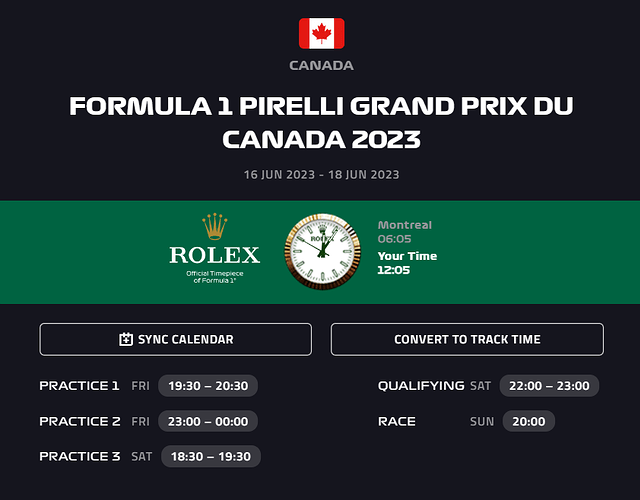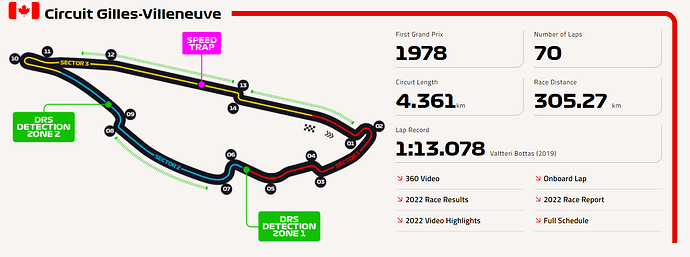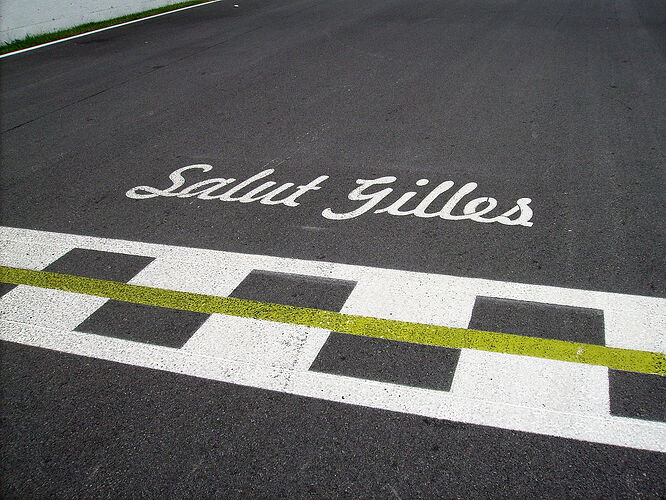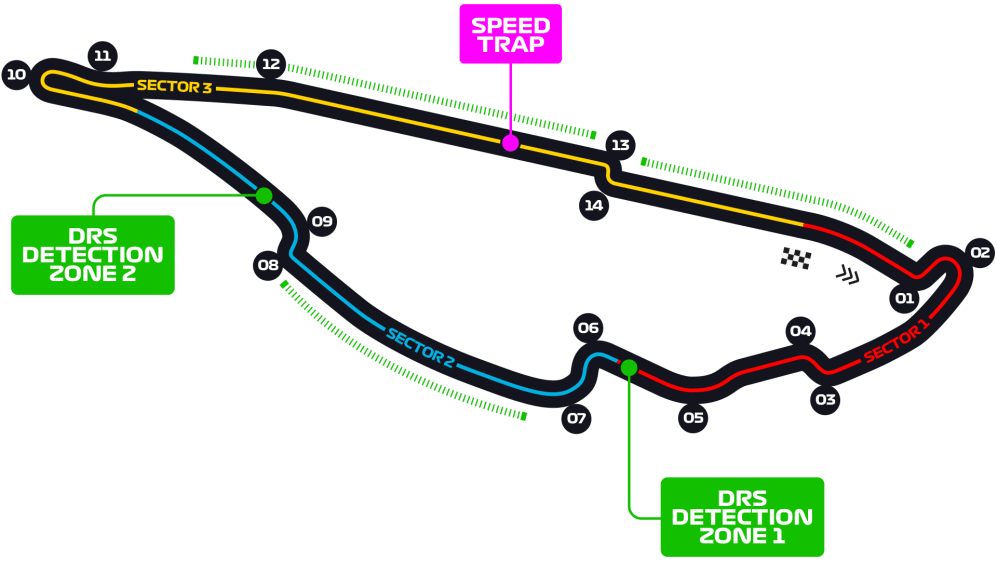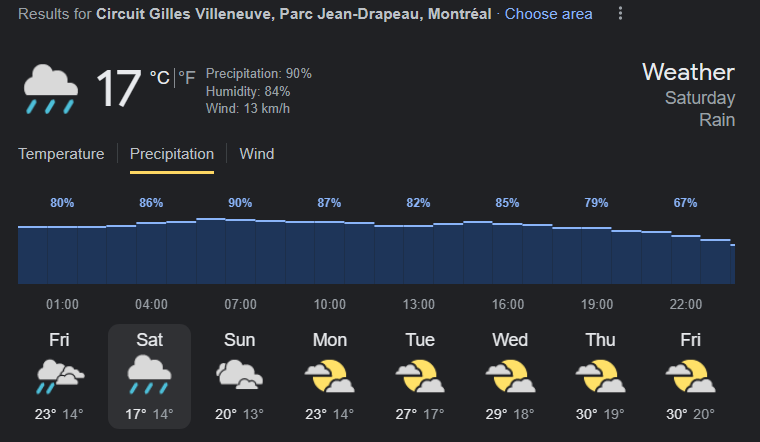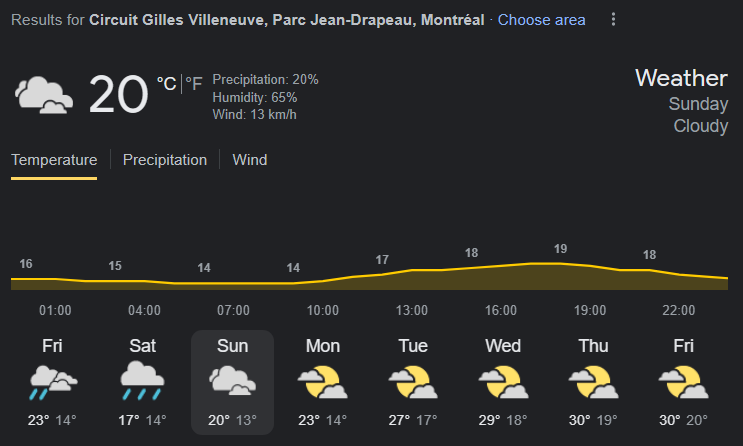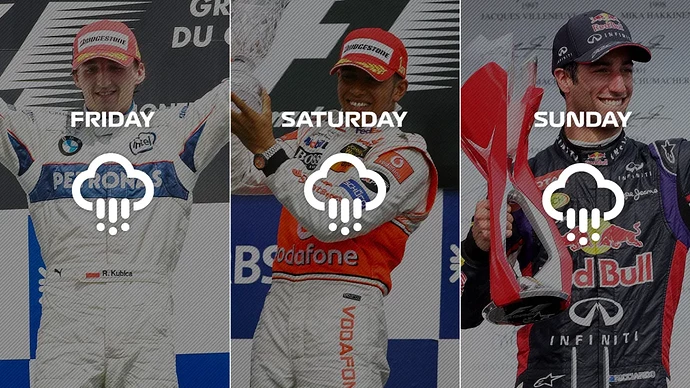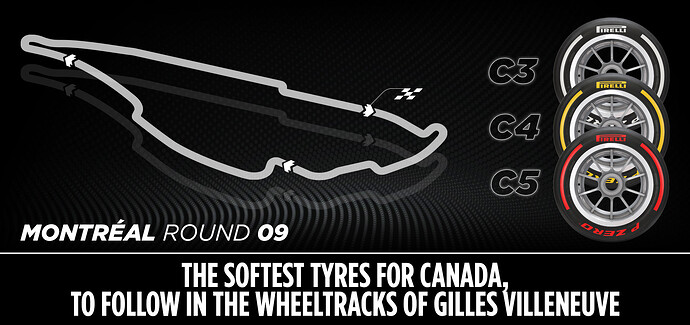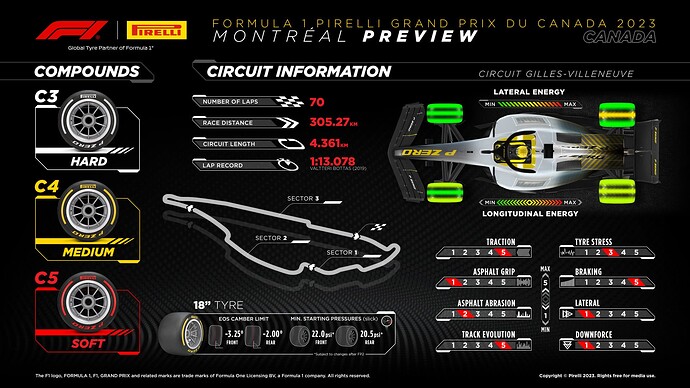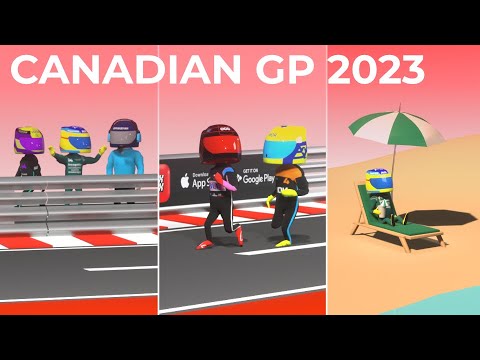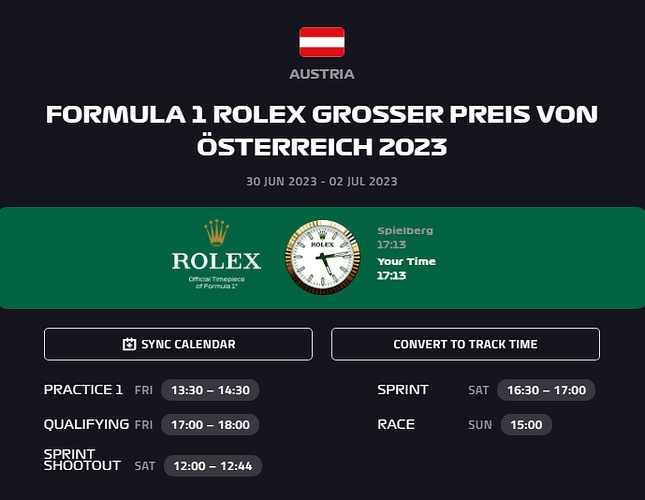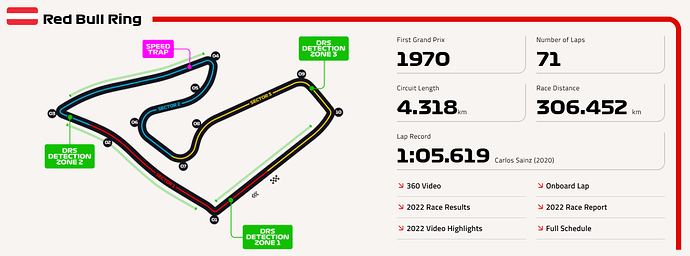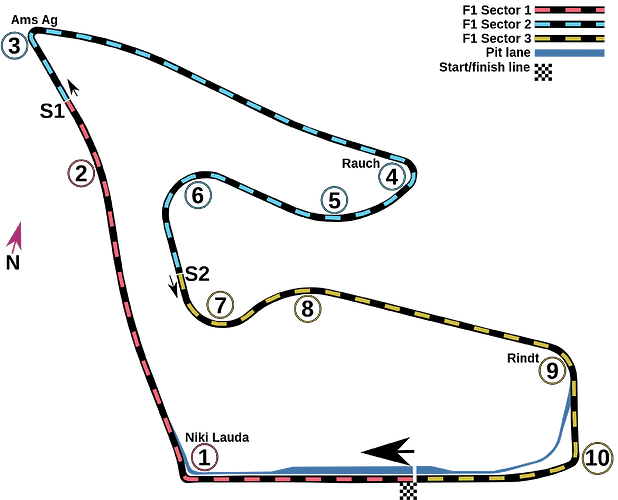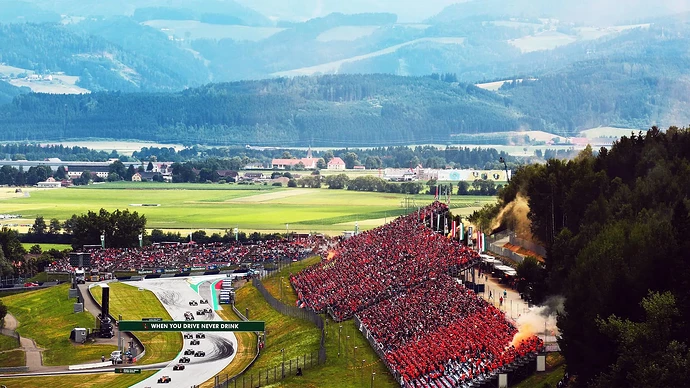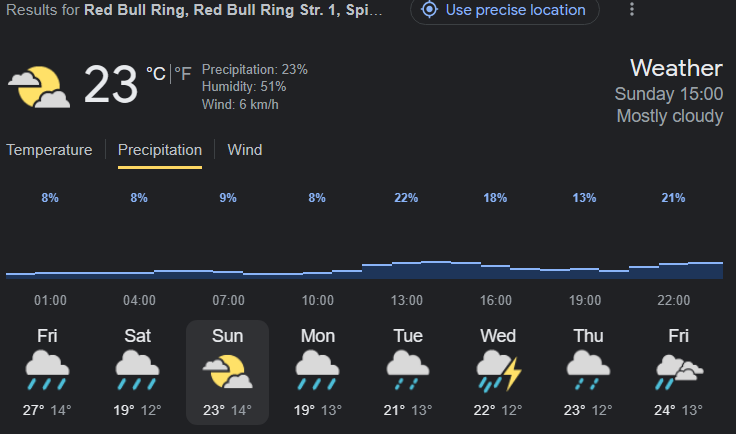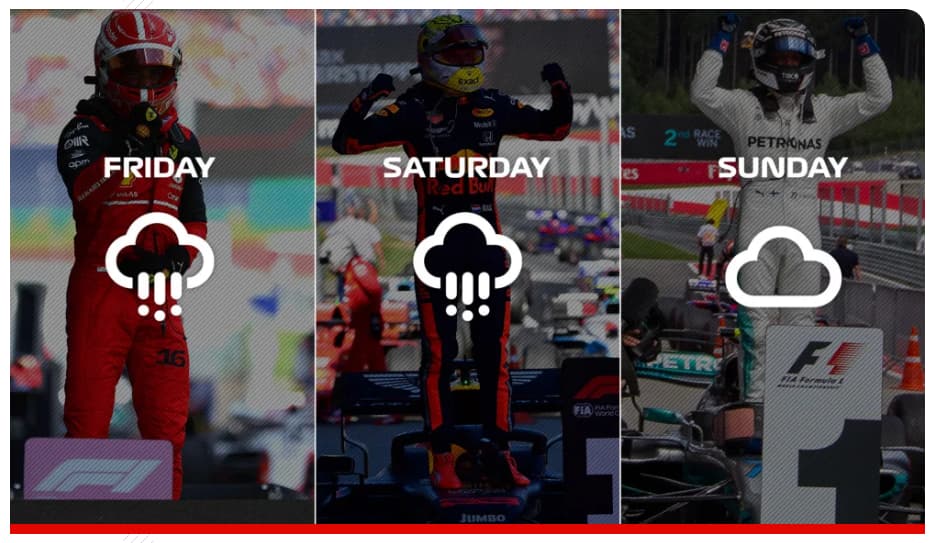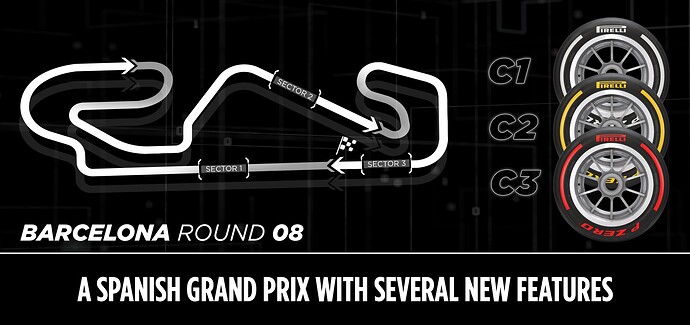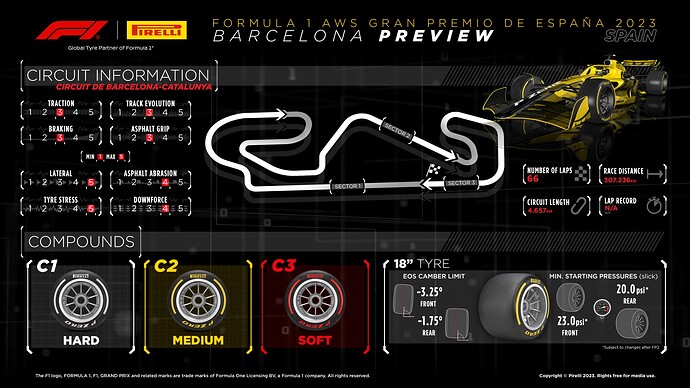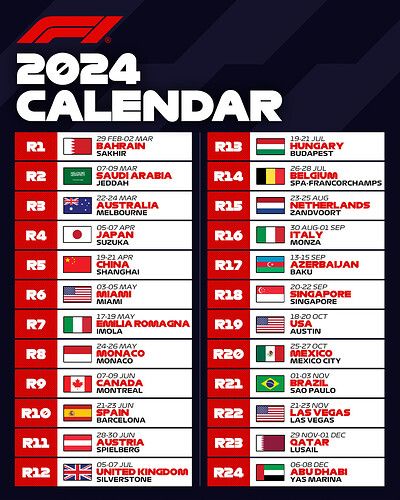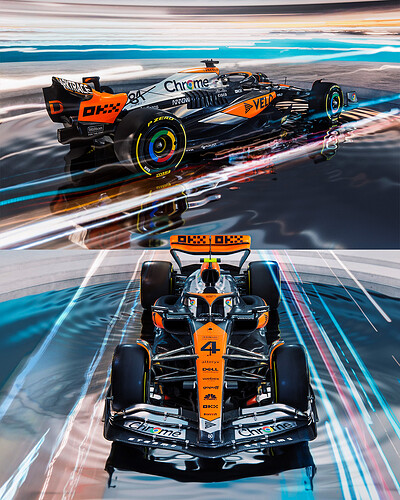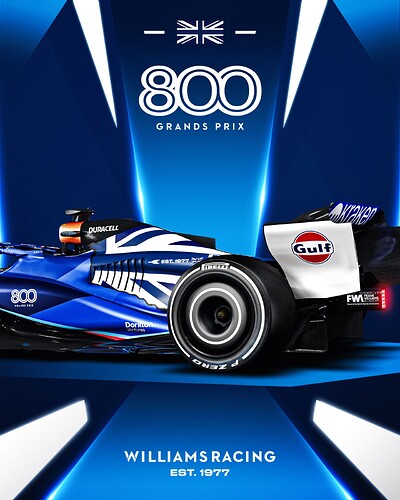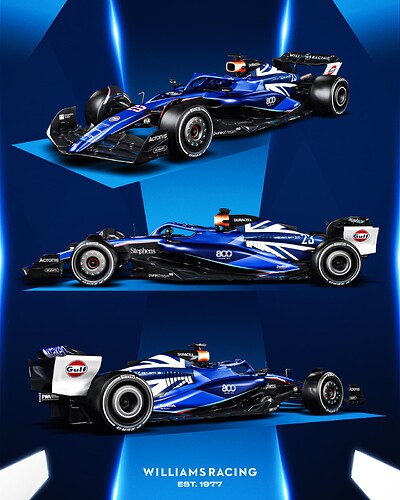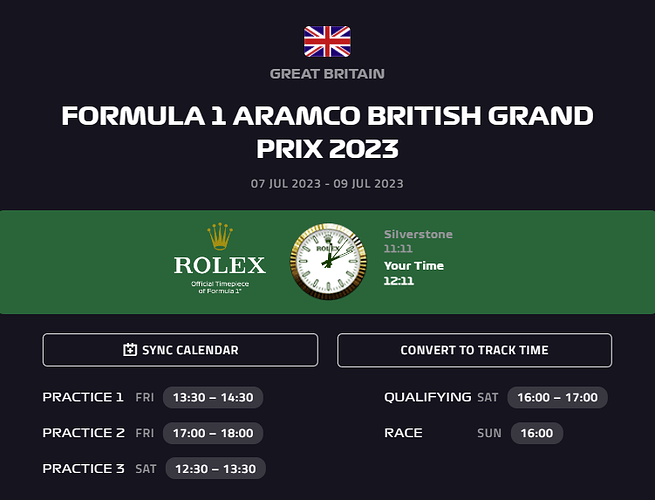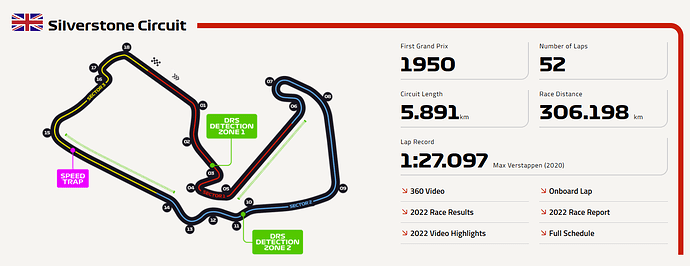The title “Rogue One” works here too… ![]()
2023 Canadian Grand Prix 
Circuit Gilles Villeneuve | Notre Dame Island | Montreal | Canada | 18 June
2023 Season - Round 8/22
Formula 1 heads to North America for the second time this year. It’s the Canadian Grand Prix at the famous Circuit Gilles Villeneuve. World Champion Max Verstappen comes into the weekend having won the last three races in a row. He is currently comfortably at the top of the 2023 Drivers’ Championship with 170 points – 53 ahead of his Red Bull teammate Sergio Perez.
Verstappen won last year’s race in Montreal and will be looking to repeat that this weekend to make it four wins in a row, and six out eight wins for the season so far. Pressure on Max will come from Perez who has faded a little in the last few races after his very strong start to the season. The resurgent Mercedes team and the upgrade-laden Aston Martins are also going to be pushing the Dutchman. (Perhaps even the two Ferraris. Maybe. If they don’t get too dazed and confused by the change in time zones from Europe. Big maybe. Big if.)
All the drivers will be facing another big challenge for the weekend: there is a high chance of rain on all three days in Montreal. Last year we had rain in Qualifying that saw Alonso put the Alpine on the front row and KMag starting P5 in the Haas. And Sergio walking disconsolately back to the pits through the bushes at the water’s edge. Could this year produce a few more rainy surprises?
Vital Statistics
- First Canadian GP – 1961, F1 Championship since 1967 (Mosport Park)
- Number of times Held: 57, 51 in F1 Championship
- First Canadian GP at CGV - 1978 (as Circuit Île Notre-Dame)
- Track Length – 4.361 km
- Number of Turns - 14
- DRS Zones - 2
- Number of Laps - 70
- Race Distance - 305.270 km
- Race Lap Record – Valtteri Bottas, Mercedes, 2019 (1:13.078)
– - Pole Turn 1 Braking Point – 186 metres
- Overtakes Completed in 2022 – 51
- Safety Car Probability – 50%
- Virtual Safety Car Probability – 50%
- Pit Stop Time Loss – 18.37 seconds
– - Most Pole Positions - Michael Schumacher (7)
- Most Wins (Drivers) – Michael Schumacher, Lewis Hamilton (7)
- Most Wins (Constructors) - Ferrari (14)
Last Race (2022)
- Pole Position - Max Verstappen, Red Bull (1:21.299)
- P1. Max Verstappen, Red Bull (1:36:21.757)
- P2. Carlos Sainz, Ferrari (+0.993)
- P3. Lewis Hamilton, Mercedes (+7.006)
- Fastest Lap - Carlos Sainz, Ferrari (1:15.749)
Most Recent Canadian GP Pole Positions
- 2022 – Max Verstappen (Red Bull)
- 2019 – Sebastian Vettel (Ferrari)
- 2018 – Sebastian Vettel (Ferrari)
- 2017 – Lewis Hamilton (Mercedes)
- 2016 – Lewis Hamilton (Mercedes)
Most Recent Canadian GP Winners
- 2022 – Max Verstappen (Red Bull)
- 2019 – Lewis Hamilton (Mercedes)
- 2018 – Sebastian Vettel (Ferrari)
- 2017 – Lewis Hamilton (Mercedes)
- 2016 – Lewis Hamilton (Mercedes)
Random Trivia
- Canada played host to the longest race in F1 history in 2011, with the clock stopping at four hours, four minutes and 39 seconds
The Schedule
Summer racing in North America means we have some evening and late night F1 action to look forward to this weekend.
FP1 on Friday is at 19:30, while FP2 gets the green flag at 23:00. Practice 3 on Saturday at 18:30 allows you to grab some dinner before Qualifying at 22:00. Lights oit for Sunday’s race is then at 20:00 - you’ll have to do a double feature movie night next week.
The Circuit
With safety concerns at the Mosport Park blighting the 1977 Canadian GP it was decided to move the race to the new circuit in Montréal. Originally named the Île Notre-Dame Circuit, the circuit was built and finished in 1978. In 1982, it was renamed in honour of Canadian Formula One driver Gilles Villeneuve, father of Jacques Villeneuve, following his death earlier in the year.
The circuit is located in a part of the city of Montréal known as Parc Jean-Drapeau. The park is named after the mayor of Montréal who was responsible for the organization of Expo 67. The race circuit is on Notre Dame Island, a man-made island in the St. Lawrence River most of which was originally built up for the Expo in 1967. Saint Helen’s Island to the northwest was artificially enlarged for the Expo '67 fairgrounds and a prominent remnant of the fair, the Biosphere can be regularly seen during television coverage of racing events. Almost half of the track – from the hairpin turn until after the pit area – runs alongside the Olympic Basin, a huge rectangular basin which was created for the rowing and canoeing events of Montréal’s 1976 Summer Olympics.
Barriers run close to the circuit and many experienced drivers have been caught out by them. A particularly famous part of the circuit is the wall on the outside of the exit of the final chicane before the start/finish straight. In 1999 the wall, which bears the name Bienvenue au Québec (“Welcome to Quebec”) giving it the nickname “Mur du Québec” (Quebec Wall), ended the race of three Formula One World Champions, Damon Hill, Michael Schumacher and Jacques Villeneuve along with FIA GT champion Ricardo Zonta. Since then the wall has been nicknamed “The Wall of Champions”. In subsequent years, 2009 world champion Jenson Button (2005) and four time World Champion Sebastian Vettel (2011, during free practice) also became victims of the wall.
When was the track built?
The man-made Notre Dame Island in the middle of the St Lawrence River was created for the 1967 Expo 67 World’s Fair. Once the expo and the ensuing 1976 Montreal Summer Olympics had left town, some clever people decided to make a race track out of the island’s roads. And lo, the Circuit Ile Notre-Dame, as it then was, came to be.
When was its first Grand Prix?
With the Canadian Grand Prix having been in search of a permanent home for a number of years in the 1960s and 1970s, the Circuit Ile Notre-Dame first hosted the race in 1978. Fittingly, Gilles Villeneuve claimed his maiden win, at the track that would end up bearing his name.
What’s the circuit like?
The fast, low-downforce circuit is one of the drivers’ favourites. The track is quite stop-start, with lots of heavy-braking chicanes and the famous hairpin to get the anchors working hard. Out of the corners, though, the track is quick and flowing, while the most iconic piece of the circuit comes right at the end of the lap: the Wall of Champions, so-called after excursions into it from Damon Hill, Jacques Villeneuve and Michael Schumacher during the 1999 Canadian Grand Prix weekend.
The Driver’s View - Jolyon Palmer, former Renault F1 driver
Canada is a really nice track to drive and you get a sense of atmosphere going around it. Overhanging trees give it the feel of a park and it feels like a street circuit – in essence, it is. There are a lot of slow-speed corners, the walls are very close in a lot of places, but it’s a great racetrack. You need a good front-end to get your car turned into the chicanes, which are pretty much everywhere.
Then there’s the hairpin, which launches you into an overtaking area at the final chicane. If not there, maybe you’ll have a little sniff of something into Turn 1. Turns 1 and 2 are pretty tricky because you’re approaching Turn 1 very, very fast, arcing to the right as you’re braking, and then hurling speed to the left.
If you have any sort of moment coming to Turn 1, you’re really off-line or cutting the corner down towards Turn 2. And tyre warm-up sometimes isn’t ideal here, particularly on chillier days in Montreal.
The Weather
Last June, rain hit Montreal on Saturday leading to a wet Qualifying that provided one of the biggest surprises of the season: Fernando Alonso sticking the Alpine second for his first front row start in nearly 10 years. And the weather forecast for this weekend is looking very much like we are going to have a repeat performance - heavy rain on Saturday - with Fernando now in the very fast Aston Martin with a bunch of new upgrades to boot. Could the Spanish rain king snatch his first pole since the German Grand Prix in 2012?
The rain clouds clear up on Sunday so the race itself may well be dry. But there is definitely a chance of rain throughout Sunday afternoon - anyone fancy a mid-race downpour to shake things up?
Friday - FP1 and FP2
Expected to be a dry morning but expect an unsettled afternoon with rain highly likely to fall in FP2.
FP1: 22°C | FP2: 20°C
Max: 22°C | Min: 14°C
Chance of rain: 60%
Saturday – FP3 and Qualifying
A cloudy and rainy day expected with a chance of intense showers along with light winds at various times.
FP3: 17°C | Q: 19°C
Max: 20°C | Min: 14°C
Chance of rain: 80%
Sunday – Grand Prix
Sunday is expected to be much improved but expect a mix of showers and some sunny spells throughout the day.
RACE: 23°C
Max: 23°C | Min: 14°C
Chance of rain: 40%
The Tyres
- For the Formula 1 Pirelli Grand Prix du Canada, the compounds chosen are C3 as P Zero White hard, C4 as P Zero Yellow medium, and C5 as P Zero Red soft.
- The Gilles Villeneuve circuit is a 4.361-kilometre semi-permanent track built on the artificial Notre Dame island in the middle of the St. Lawrence River, close to Montreal. Outside of the grand prix its used as a leisure facility for cycling, roller skating, and walking.
- The first Canadian Grand Prix held on this track was in 1978, with Gilles Villeneuve emerging as the winner. The track was renamed in memory of the Canadian driver a few weeks after his tragic death in 1982.
- The race runs for 70 laps, consisting of six left turns and eight right turns with three straights (including a very long one). Average speed is relatively low, thanks to the frequent changes of direction caused by the close succession of corners, with continuous braking.
- The softer compound is usually seen only in qualifying, as was the case last year when just the medium and hard compounds were used in the race. The strategy preferred by most drivers was a two-stop strategy but some opted for a one-stopper with a very long initial stint on hard; especially those starting close to the back.
- Based on last year’s data, the average time taken for a pitstop is 18.5 seconds, despite more than 400 metres of pitlane. Drivers coming into the pits cut through the last chicane and skip the first corner, with the pit exit already in Turn 2
Allons faire la course au Canada! ![]()
- Max sounding perfectly positive, despite the wet weather forecast. (Or because of it?)
- Daddy Stroll looking for a double podium - quite possible for Fernando, but very optimistic to think Lance will join him. And the look on Lance’s face suggests he thinks the same

- George speaking still grates me no end - don’t know why.
- Ferrari drivers with the PR spin brave face “try to maximise our package” spiel.
- Alpine Frenchies sounding more optimistic than the Ferrari’s.
- Lando not pretending to have a huge amount of faith any more.
- Valtteri’s got even more mullet going on.
- Everyone mentioning the weather and rain changing things.
- KMag’s 150th Grand Prix

Jissie Ferrari strategy opposite everyone. This better work out. My fok.
Also Sausage curbs strikes again, been wondering who’s going to hit it proper. Keep hoping it’s not a Ferrari.
Oh wow. It worked out. Well done with that gamble of a strat. How did their mediums hold up haha, ahead of one Red Bull is ok, but dammit we defs going to forfeit to Merc on the constructors.
Also albon 7th! Epic stuff for Williams. And lastly, sweet stuff seeing Norris so racey.
I was sad for Norris getting that 5sec he had good race
Flippen, unsportsmanship behaviour lol. wtf man.
also just thinking back now, if not for Norris, it was actually a little bit of a boring race. DRS trains and seems like even the ones ahead of said train can’t get overtaken. no one really seemed to challenge someone
Yea I wont lie I was upset at that penalty. At least he didn’t let it get to him, he drove the wheels off that Macca, I was happy to see the old Lando on track
2023 Austrian Grand Prix 
Red Bull Ring | Spielberg | Steiermark | Austria | 2 July
2023 Season - Grand Prix 9/22 | Sprint Race 2/6
Back to Europe for a quartet of Grands Prix crammed into a five week block before the traditional mid-season break kicks in. We’ve got Austria and Britain back-to-back, then a one week break before Hungary and Belgium. This weekend is also the second of the Season’s six Sprint Race events, so a bunch of extra Championship points are up for grabs in the Styrian hills.
Vital Statistics
- First Grand Prix – 1964 (Zeltweg)
- Track Length – 4.318km
- Lap record – 1m 05.619s, Carlos Sainz, McLaren, 2020
- Most pole positions – Alain Prost and Max Verstappen (3)
- Most wins – Niki Lauda, Rene Arnoux, Nelson Piquet and Valtteri Bottas (3)
- Trivia – Austria’s Red Bull Ring has the fewest corners on the F1 calendar, with just 10 turns making up the layout
- Pole run to Turn 1 braking point – 233 metres
- Overtakes completed in 2022 – 135
- Safety Car probability – 50%
- Virtual Safety Car probability – 20%
- Pit stop time loss – 20.41 seconds
The Schedule
Back to European summer time thankfully, so the scheduled times for the weekend are back to being sensible again. Keeping in mind that we have a Sprint Race weekend, here’s the times:
The Circuit
The Red Bull Ring is a motorsport race track in Spielberg, Styria, Austria. The race circuit was founded as Österreichring (translation: Austrian Circuit) and hosted the Austrian Grand Prix for 18 consecutive years, from 1970 to 1987. It was later shortened, rebuilt and renamed the A1-Ring (A Eins-Ring), and it hosted the Austrian Grand Prix again from 1997 to 2003.
When Formula One outgrew the circuit, a plan was drawn up to extend the layout. Parts of the circuit, including the pits and main grandstand, were demolished, but construction work was stopped and the circuit remained unusable for several years before it was purchased by Red Bull’s Dietrich Mateschitz and rebuilt.
Renamed the Red Bull Ring the track was reopened on 15 May 2011 and subsequently hosted a round of the 2011 DTM season and a round of the 2011 F2 championship. Formula One returned to the circuit in the 2014 season, and MotoGP returned to the circuit in the 2016 season. The Red Bull Ring also hosted a second F1 event named the Styrian Grand Prix in 2020 and 2021 during the Covid pandemic.
When was the track built?
The fearsome, original Osterreichring was originated in 1969 as a replacement for the Zeltweg airfield circuit. The track known today as the Red Bull Ring was more or less created over the winter of 1995-6, when Hermann Tilke was engaged to turn the Osterreichring into a shorter, more modern race track.
When was its first Grand Prix?
The A1-Ring, as it was then called, was opened in 1996, with Formula 1 arriving at the circuit a year later. Jacques Villeneuve won the race, while Jean Alesi had a spectacular crash when his Benetton climbed up the Ferrari of Eddie Irvine. Alesi’s team mate Gerhard Berger, meanwhile, used his home Grand Prix to announce his F1 retirement.
What’s the circuit like?
It’s only wee, bless it, but the Red Bull Ring packs a lot into a short lap. The first half rewards power, as the cars blast along three straights separated by a pair of uphill right-handers. But then as the drivers work their way downhill, the circuit becomes a regular toboggan ride, as the cars canyon through a series of quick corners, including the exhilarating Rindt right-hander, named for Austria’s first F1 champion.
The Driver’s View - Jolyon Palmer, former Renault F1 driver
Austria is a picturesque circuit, really undulating, which makes it nice to drive and characterful.
You’ve got to be careful with the kerbs as it’s very easy to get straddling or to get over some more abrasive kerbs, which can inflict a bit of damage to your car. But beyond that, it’s a short and relatively simple circuit with some hidden technicalities.
Turn 1 is always quicker than you think it’s going to be, but braking is the order of the day for the first sector. Turn 4, a downhill braking zone, is the easiest one to mess up – so many drivers end up in the gravel there on the exit.
There’s overtaking aplenty in Turns 3 and 4, and then the flow through the second half of the lap is really good as it just comes around so quickly. It’s one of the fastest on the calendar and it really feels it at the wheel. You barely get a breath through this Grand Prix.
The Weather
Sunny and mild for most of the weekend, but with a chance of rain on Friday afternoon around Qualifying, and a high chance of rain for Saturday’s Sprint Race. The Grand Prix proper on Sunday may stay good and dry, but a shower or two popping off mid-race may still happen.
Friday - FP1 and Qualifying
Expected to be sunny in the morning but with increased chance of rain hitting the track in the afternoon.
FP1: 24°C | Q: 21°C
Max: 25°C | Min: 13°C
Chance of rain: 60%
Saturday – Sprint Shootout and Sprint Race
High chance of showers in the afternoon with possible thunderstorms.
SS: 20°C | SR: 19°C
Max: 21°C | Min: 14°C
Chance of rain: 80%
Sunday – Grand Prix
Partly cloudy in the morning with a slight chance of rain hitting the race in the afternoon.
GP: 24°C
Max: 25°C | Min: 13°C
Chance of rain: 20%
The Tyres
- The teams will have the C3 compound as P Zero White hard, C4 as P Zero Yellow medium and C5 as P Zero Red soft at the Austrian Grand Prix. Just like the last race at Montréal, the three softest compounds in the Pirelli F1 range have been nominated.
- The Spielberg weekend will be the second grand prix on the calendar featuring an F1 Sprint. Qualifying to decide the starting grid for the Grand Prix is scheduled for Friday afternoon, after a single free practice session in the morning. Saturday will instead be dedicated to the Sprint Shootout and the Sprint Race. During the three short sessions that make up the Sprint Shootout (lasting 12, 10, and eight minutes respectively) teams will have to fit new tyres and use the medium compound for Q1 and Q2. In Q3, only the soft compound will be used.
- The Red Bull Ring has only 10 corners, with the shortest lap time of any track on the championship. The lap record is held by Ferrari’s Carlos Sainz, who completed lap 68 of the 2020 Styrian Grand Prix in a time of 1m05.619s, driving a Renault-powered McLaren on P Zero soft (C4) tyres.
- The driver with the most wins on the current version of the Austrian track is Red Bull’s Max Verstappen, with four wins from the 18 races held since 1997. The most successful manufacturer is Mercedes with six wins, courtesy of Nico Rosberg, Lewis Hamilton, and Valtteri Bottas – who all claimed two races each.
- Most drivers made two stops last year, starting on the medium ahead of two stints on the hard. There was plenty of overtaking, particularly in the midfield, with five cars competing for the places just off the podium.
- The elevation changes at the Red Bull Ring put it second only to Spa-Francorchamps in terms of variation. There’s a change of more than 60 metres between the lowest point on the track – just before Turn 1 – and the highest point, after Turn 2.
Lass uns RennenFahrenn! ![]()
Pretty decent race weekend in Austria. Both the Sprint Race and the Grand Prix had some excellent racing (behind Max obviously).
All of this marred by the utter fiasco of the 1200 Track Limits infringement reviews and multiple penalties. Aston Martin’s post-race challenge to the Race Stewards resulted in even more penalties and changes to the race results.
There was some amazing action on track, and overall I enjoyed the race. the track limits thing really needs to be addressed some of the penalties was mental
Happy with Norris’ race, also with Le Clerc’s although Ferrari shafted Sainz in order to protect Le Clerc, so not all good in that camp. But definitely better. Some nice battles on track, I got cut off after an hour of racing though due to loadshedding and I was not at home to just plug in my inverter.
And yeah, track limits was a bit of a lol, 15 laps in and already you had your first penalty, that’s crazy. And since then Lewis played the role of the stewards haha, reporting literal everyone.
Formula 1 has made clear its intention to move towards greater calendar regionalisation, reducing logistical burdens and making the season more sustainable.
By moving Japan to April, Azerbaijan to September and Qatar back-to-back with Abu Dhabi, this calendar creates a better flow of races in certain regions, and this work will continue while being realistic to the fact that as a world championship, with climatic and contractual constraints, there will always be travel required that cannot be completely regionalised.
For the opening two races of the season in Bahrain and Saudi Arabia, the Grand Prix will take place on a Saturday. This decision has been taken to accommodate Ramadan.
Will be interesting to see the reaction to Thursday - Friday - Saturday race weekends. China back in the good books. No sign of any return to either Germany or France. (And probably no space.) And obviously no ![]() flag in the list.
flag in the list.
Williams will also be sporting a flashy new livery this weekend, celebrating their 800th Grand Prix.
so sad man…
2023 British Grand Prix 
Silverstone Circuit | Silverstone | England | 9 July
2023 Season - Grand Prix 10/22
Very low key preview post right now - too much other stuff to do. May get back to it with the usual stuff later. Not that it’ll matter - I just realised that I put the Spanish GP tyre images into my Austria post last week and no one noticed ![]()
Vital statistics
- First Grand Prix – 1950
- Track Length – 5.891km
- Lap record – 1m 27.097s, Max Verstappen, Red Bull, 2020
- Most pole positions – Lewis Hamilton (7)
- Most wins – Lewis Hamilton (8)
- Trivia – Silverstone was the first Grand Prix, hosting the inaugural Formula 1 World Championship round on May 13, 1950
- Pole run to Turn 1 braking point – 239 metres
- Overtakes completed in 2022 – 70
- Safety Car probability – 89%*
- Virtual Safety Car probability – 22%*
- Pit stop time loss – 19.92 seconds
The Schedule
The Circuit
Silverstone
When was the track built?
Little did those laying the perimeter road to the RAF Silverstone airfield in 1942 know that they were setting down what would become one of the world’s greatest race tracks. But, well, they were! The Silverstone circuit was first used for a proper motor race in 1947 – although sadly, a local sheep lost its life during the proceedings…
When was its first Grand Prix?
Silverstone was the first Grand Prix, hosting the inaugural Formula 1 World Championship round on May 13 1950. Old campaigner Giuseppe Farina, who’d take that year’s title, won the race in his Alfa Romeo 158.
What’s the circuit like?
At the 2018 British Grand Prix, Lewis Hamilton compared a flat-out lap around Silverstone to flying a fighter jet, which should tell you all you need to know about the Northamptonshire circuit. Despite numerous layout changes over the years, Silverstone has always maintained its essential character as one of the fastest tracks on the F1 calendar, while historic corners like Maggotts, Becketts and Abbey provide some of the biggest challenges for racing drivers anywhere in the world.
The driver’s verdict | Jolyon Palmer, former Renault F1 driver:
Silverstone is another drivers’ favourite with fast, flowing sequences and some of the best corners in the world. Copse, Maggots and Becketts are where you feel G-force on your body that is pretty rare in Formula 1.
Copse is a big challenge even though there’s run-off – you go so quick that if anything goes wrong there you’re still going to be in trouble. And then the change of direction through Maggots and Becketts is quite a lot of fun.
Slowing it down through the final part of that is the key to make sure you get the exit onto the Hangar Straight as well – it’s about finding a rhythm through those sweeping parts. All of this puts a lot of strain on the front-left tyre and we’ve seen some issues here in the past.
Abbey is the one that is flat-out, but if you’re tucked in behind someone in race conditions it can be on the edge. Overtaking is also very possible with the new loop that’s not very new anymore – Turn 3 if you fancy a lunge, Turn 6 as well.
Maybe the hardest corner on the circuit is Brooklands, a big braking zone where it’s easy to just trail a bit of brake into the apex and snatch a wheel there. It’s so good as an overtaking area but also an easy area to make a little mistake.
Race News


